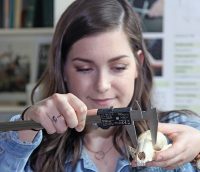 Social Sciences
Social Sciences
How to Weigh a Raccoon
What we consider to be food waste, raccoons are eager to devour as dinner. These masked mammals have adapted to thrive near people, feeding off the edibles that we discard.
Given that humans are getting bigger—and heavier—due in part to lavish eating habits, Carly Pate wondered if the same is holding true for the raccoons living among us. Have they grown bigger over time?
That was two years ago, and she’s still looking for an answer. But Pate has already made an important discovery: In-depth anthropological research suits her.
In an effort to answer her question, Pate (below), a senior in biological anthropology and general science, is conducting an advanced level of investigation that is typically undertaken only by experienced researchers. She is analyzing statistical data and physical specimens based on information she has gathered at private collections, and has even developed an approach for determining animal weights that could be useful for other researchers in her field.
“Carly is unusual in that she formed her own research questions and has worked mostly without assistance,” said Frances White, anthropology department head and Pate’s adviser. “It’s an outstanding example of an undergraduate engaging in research more like a graduate student.”
Pate first started pondering the raccoon-weight question while taking a course in evolutionary medicine as a freshman. But in searching for an answer, she found nothing useful in websites, scientific journals or scholarly databases about variation in raccoon weights over time.
Intrigued and inspired, Pate focused on a method that undergirds much of anthropological research—establishing a physical record.
Anthropologists routinely make determinations about physical characteristics of humans and animals based on specific measurements of bones kept in collections.
But no approach had been established for estimating raccoon weights. Stephen Frost, an associate professor of anthropology, coached Pate in the protocols used for determining size in other primates and White helped with calculations that convert bone measurements into predicted body weights.

Carly Pate studied raccoon bones at the American Museum of Natural History in New York, courtesy of funding support from the anthropology department.
Pate set about examining six raccoon skeletons housed in the department’s Primate Osteology Lab, measuring different bones and tweaking her formulas until her method produced estimates for weights that matched the record for each specimen at the time of death.
She found that a single measurement accurately predicted raccoon weight: the distance between the eyeball sockets, called the interorbital breadth. A measurement of 20.28 millimeters, for example, predicted a body weight of 6.82 pounds.
Armed with an approach for answering her question, Pate set about gathering data. She needed to measure as many skeletons as possible, so she began visiting collections—including the repository of the largest supply of raccoon bones in the country, the American Museum of Natural History in New York.
With funding support from the anthropology department, Pate visited the world’s third-largest museum for five days. No less thrilling than the access to 400 usable specimens, Pate said, was the opportunity to walk among the vast collections within the cavernous institution.
That was in September 2016; Pate is now applying her methodology to determine if raccoons are getting bigger. In the coming months, she plans to visit collections in Chicago and Washington, DC, for additional data.
But regardless of whether she answers her question before graduating next spring, animals—and possibly raccoons—are in Pate’s future. She plans to go to veterinary school, with the long-term goal of doing fieldwork in the wild.
—Jim Murez


 Twitter
Twitter Facebook
Facebook Forward
Forward